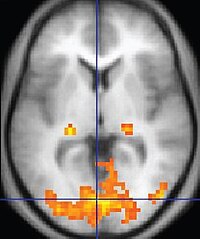
Photo from wikipedia
Objectives Breast cancers are classified as invasive or noninvasive based on histopathological findings. Although time-intensity curve (TIC) analysis using magnetic resonance imaging (MRI) can differentiate benign from malignant disease, its… Click to show full abstract
Objectives Breast cancers are classified as invasive or noninvasive based on histopathological findings. Although time-intensity curve (TIC) analysis using magnetic resonance imaging (MRI) can differentiate benign from malignant disease, its diagnostic ability to quantitatively distinguish between invasive and noninvasive breast cancers has not been determined. In this study, we evaluated the ability of TIC analysis of dynamic MRI data (MRI-TIC) to distinguish between invasive and noninvasive breast cancers. Material and Methods We collected and analyzed data for 429 cases of epithelial invasive and noninvasive breast carcinomas. TIC features were extracted in washout areas suggestive of malignancy. Results The graph determining the positive diagnosis rate for invasive and noninvasive cases revealed that the cut-off θi/ni value was 21.6° (invasive: θw > 21.6°, noninvasive: θw ≤ 21.6°). Tissues were classified as invasive or noninvasive using this cut-off value, and each result was compared with the histopathological diagnosis. Using this method, the accuracy of tissue classification by MRI-TIC was 88.6% (380/429), which was higher than that using ultrasound (73.4%, 315/429). Conclusion MRI-TIC is effective for the classification of invasive vs. noninvasive breast cancer.
Journal Title: Journal of Clinical Imaging Science
Year Published: 2022
Link to full text (if available)
Share on Social Media: Sign Up to like & get
recommendations!